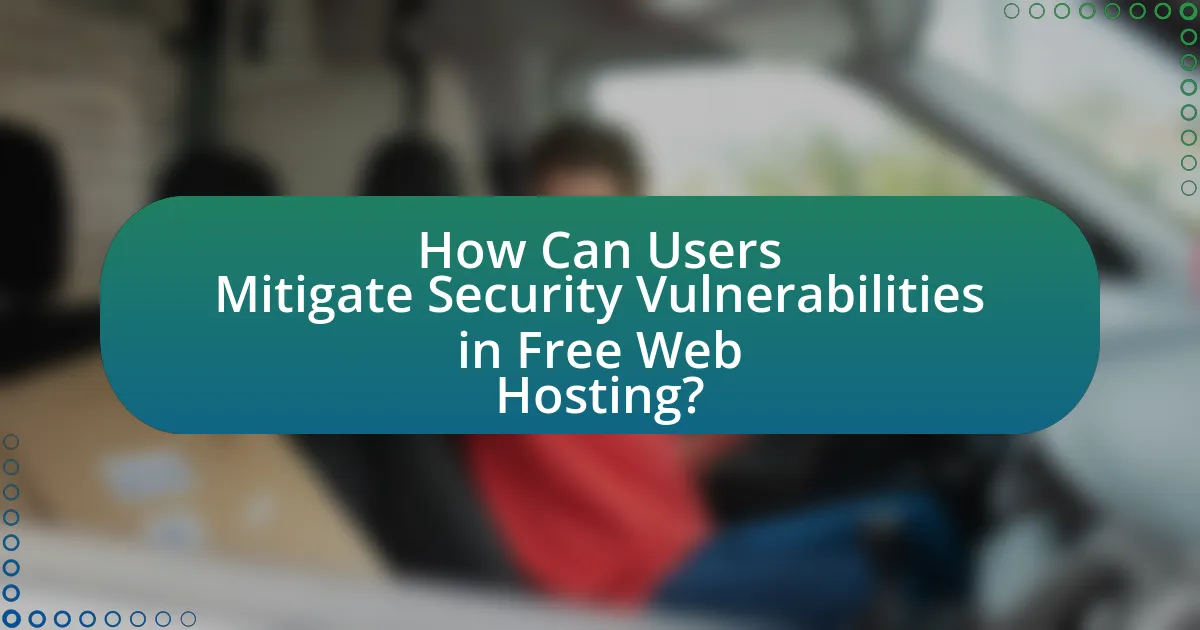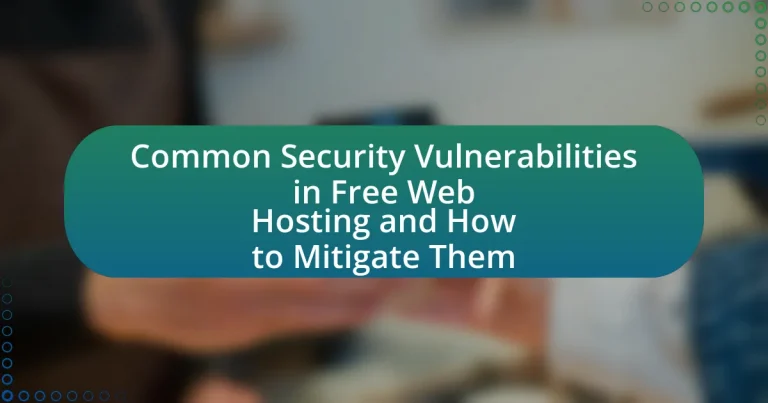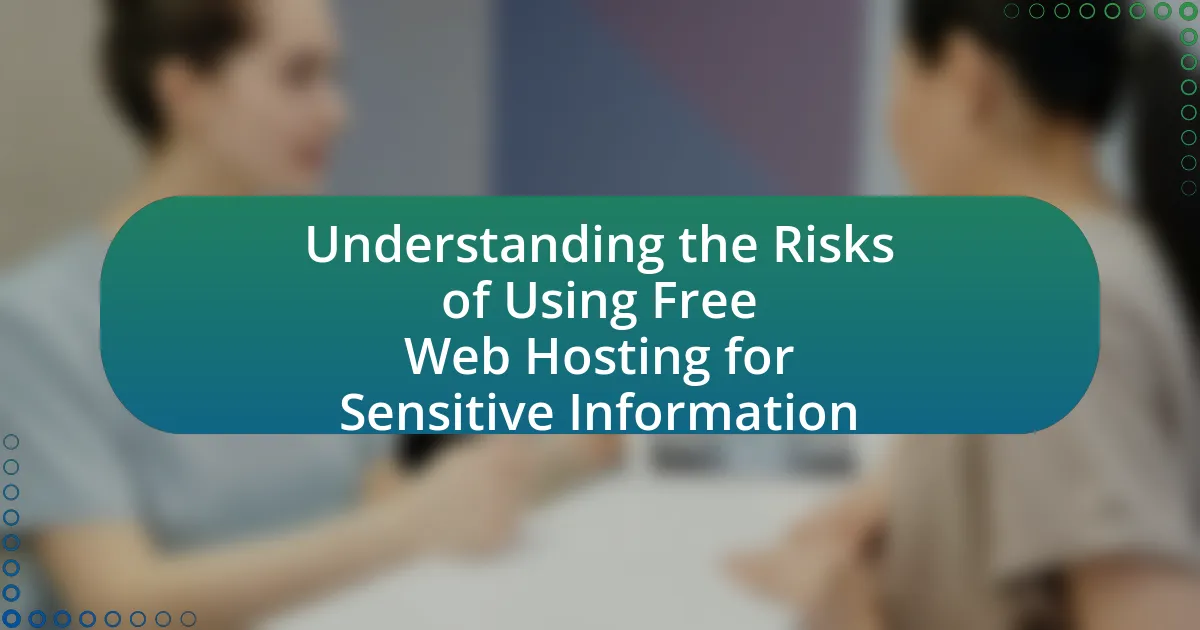The article focuses on common security vulnerabilities associated with free web hosting services and strategies for mitigating these risks. It identifies key vulnerabilities such as inadequate security measures, lack of regular updates, and shared resources that can lead to data breaches and unauthorized access. The discussion includes the types of sensitive data at risk, the impact of these vulnerabilities on users, and the limitations imposed by free hosting services. Additionally, the article outlines best practices for enhancing security, including the implementation of strong passwords, regular software updates, and the use of security tools and plugins. It emphasizes the importance of a comprehensive security plan to prevent future breaches and protect user data effectively.

What are Common Security Vulnerabilities in Free Web Hosting?
Common security vulnerabilities in free web hosting include inadequate security measures, lack of regular updates, and shared resources. Inadequate security measures often result from limited budgets, leading to weak firewalls and insufficient intrusion detection systems. The lack of regular updates can leave software exposed to known vulnerabilities, as many free hosting providers do not prioritize timely patches. Additionally, shared resources mean that a security breach on one site can compromise others on the same server, as they often share the same IP address and server environment. These factors collectively increase the risk of data breaches, malware infections, and unauthorized access.
How do these vulnerabilities impact users and their data?
Vulnerabilities in free web hosting significantly impact users and their data by exposing sensitive information to unauthorized access and potential exploitation. For instance, inadequate security measures can lead to data breaches, where personal data such as usernames, passwords, and financial information may be stolen. According to a report by Verizon, 43% of data breaches involve small businesses, often utilizing free hosting services with weaker security protocols. Additionally, users may face service disruptions due to attacks like Distributed Denial of Service (DDoS), which can render websites inaccessible and compromise user trust. These vulnerabilities not only jeopardize individual privacy but also can lead to financial losses and reputational damage for users.
What types of data are most at risk in free web hosting environments?
Sensitive data types most at risk in free web hosting environments include personal information, login credentials, and payment details. Free web hosting services often lack robust security measures, making them vulnerable to data breaches and unauthorized access. For instance, a study by the Ponemon Institute found that 60% of small businesses using free hosting services experienced data breaches, primarily due to inadequate security protocols. This highlights the significant risk associated with storing sensitive data in such environments.
How can these vulnerabilities lead to data breaches?
Vulnerabilities in free web hosting can lead to data breaches by allowing unauthorized access to sensitive information. For instance, misconfigured servers or inadequate access controls can enable attackers to exploit these weaknesses, gaining entry to databases containing personal user data. According to a report by Verizon, 43% of data breaches involve web applications, highlighting the significant risk posed by such vulnerabilities. Additionally, unpatched software can be exploited by attackers to execute malicious code, further compromising data integrity and confidentiality.
Why are free web hosting services more susceptible to security issues?
Free web hosting services are more susceptible to security issues primarily due to limited resources and inadequate security measures. These services often lack the financial backing to implement robust security protocols, leading to vulnerabilities such as outdated software, weak encryption, and insufficient monitoring. For instance, a study by the Cybersecurity & Infrastructure Security Agency (CISA) highlights that free hosting platforms frequently experience higher rates of malware infections and data breaches compared to paid services, as they do not prioritize security investments. Additionally, the shared nature of free hosting environments increases the risk of cross-site scripting and other attacks, as multiple users share the same server resources without adequate isolation.
What limitations do free web hosting services impose on security measures?
Free web hosting services impose significant limitations on security measures, primarily due to their lack of resources and control. These services often do not provide essential security features such as SSL certificates, firewalls, and regular security updates, which are critical for protecting websites from cyber threats. Additionally, users typically have limited access to server configurations, preventing them from implementing custom security protocols or monitoring tools. According to a study by the Cybersecurity & Infrastructure Security Agency, free hosting platforms are more susceptible to attacks like DDoS and malware infections, highlighting the inherent risks associated with inadequate security measures.
How does the lack of resources affect the security of free web hosting?
The lack of resources significantly compromises the security of free web hosting by limiting the ability to implement robust security measures. Free web hosting services often operate on minimal budgets, which restricts their capacity to invest in advanced security technologies, regular software updates, and comprehensive monitoring systems. For instance, a study by the Ponemon Institute found that organizations with inadequate resources are 50% more likely to experience a data breach. This lack of investment leads to vulnerabilities such as outdated software, insufficient encryption, and inadequate server protection, making free web hosting platforms attractive targets for cyberattacks.
What are the most common types of security vulnerabilities found in free web hosting?
The most common types of security vulnerabilities found in free web hosting include inadequate security measures, lack of software updates, and shared resources leading to cross-site scripting (XSS) and SQL injection risks. Inadequate security measures often result from the absence of firewalls and intrusion detection systems, making websites more susceptible to attacks. Additionally, many free hosting services do not regularly update their software, leaving known vulnerabilities unpatched, which can be exploited by attackers. The shared nature of free hosting environments can lead to cross-site scripting and SQL injection vulnerabilities, as malicious users can potentially access and manipulate data from other users’ sites. These vulnerabilities are well-documented in cybersecurity literature, highlighting the risks associated with free web hosting services.
What is cross-site scripting (XSS) and how does it affect free web hosting?
Cross-site scripting (XSS) is a security vulnerability that allows attackers to inject malicious scripts into web pages viewed by users. In the context of free web hosting, XSS can severely compromise user data and site integrity, as many free hosting services may lack robust security measures to prevent such attacks. For instance, a study by the Open Web Application Security Project (OWASP) highlights that XSS vulnerabilities are prevalent in applications that do not properly validate or sanitize user input. This can lead to unauthorized access to sensitive information, session hijacking, and the spread of malware, ultimately damaging the reputation of the hosting service and its users.
How does SQL injection pose a threat to free web hosting users?
SQL injection poses a significant threat to free web hosting users by allowing attackers to manipulate database queries, potentially leading to unauthorized access to sensitive data. This vulnerability arises from inadequate input validation in web applications, which is common in free hosting environments due to limited resources for security measures. For instance, a successful SQL injection attack can enable an attacker to retrieve, modify, or delete data stored in the database, compromising user information and application integrity. According to the Open Web Application Security Project (OWASP), SQL injection is consistently ranked among the top web application security risks, highlighting its prevalence and impact.
What role does inadequate server configuration play in security vulnerabilities?
Inadequate server configuration significantly contributes to security vulnerabilities by exposing systems to unauthorized access and exploitation. Misconfigured servers can lead to weak access controls, allowing attackers to gain entry and manipulate sensitive data. For instance, a study by the SANS Institute found that 80% of security breaches are due to misconfigurations, highlighting the critical nature of proper server setup. Furthermore, default settings often remain unchanged, which can leave known vulnerabilities unaddressed, making systems easy targets for cybercriminals.

How Can Users Mitigate Security Vulnerabilities in Free Web Hosting?
Users can mitigate security vulnerabilities in free web hosting by implementing strong passwords, regularly updating software, and utilizing secure protocols. Strong passwords reduce the risk of unauthorized access, while keeping software updated ensures that known vulnerabilities are patched. Additionally, using secure protocols like HTTPS encrypts data during transmission, protecting it from interception. According to a 2021 study by the Cybersecurity & Infrastructure Security Agency, 80% of data breaches involve weak or stolen passwords, highlighting the importance of password strength in security measures.
What best practices should users follow to enhance security?
To enhance security, users should implement strong, unique passwords for each account and enable two-factor authentication (2FA) wherever possible. Strong passwords reduce the risk of unauthorized access, while 2FA adds an additional layer of protection by requiring a second form of verification. According to a study by Google, 2FA can block 100% of automated bots and 96% of phishing attacks, demonstrating its effectiveness in enhancing security. Additionally, users should regularly update their software and applications to patch vulnerabilities, as outdated systems are prime targets for cyberattacks.
How can users implement strong passwords and authentication measures?
Users can implement strong passwords and authentication measures by creating complex passwords that include a mix of uppercase letters, lowercase letters, numbers, and special characters, while also enabling two-factor authentication (2FA) for added security. Research indicates that passwords should be at least 12 characters long to significantly reduce the risk of being cracked; for example, a study by the National Institute of Standards and Technology (NIST) emphasizes the importance of password length and complexity in enhancing security. Additionally, using a password manager can help users generate and store unique passwords for different accounts, further mitigating the risk of unauthorized access.
What steps can users take to regularly update their software and applications?
Users can regularly update their software and applications by enabling automatic updates, checking for updates manually, and subscribing to update notifications. Enabling automatic updates ensures that the latest security patches and features are installed without user intervention, which is crucial for maintaining security against vulnerabilities. Manually checking for updates at regular intervals, such as weekly or monthly, allows users to stay informed about the latest versions and fixes. Subscribing to notifications from software vendors provides timely alerts about critical updates, ensuring users do not miss important security patches. These practices are essential for mitigating common security vulnerabilities associated with outdated software in free web hosting environments.
What tools and resources are available for improving security in free web hosting?
To improve security in free web hosting, users can utilize tools such as SSL certificates, firewalls, and content management system (CMS) security plugins. SSL certificates encrypt data transmitted between the user and the server, enhancing data protection. Firewalls, both hardware and software, monitor and control incoming and outgoing network traffic based on predetermined security rules, effectively blocking unauthorized access. Additionally, CMS security plugins, like Wordfence for WordPress, provide features such as malware scanning, login attempt monitoring, and firewall protection, which are crucial for safeguarding websites hosted on free platforms. These tools collectively address common vulnerabilities associated with free web hosting, such as data breaches and unauthorized access.
How can users utilize security plugins to protect their websites?
Users can utilize security plugins to protect their websites by installing and configuring them to monitor, detect, and mitigate security threats. Security plugins provide features such as firewall protection, malware scanning, and login attempt monitoring, which help safeguard against common vulnerabilities like SQL injection and cross-site scripting. For instance, plugins like Wordfence and Sucuri offer real-time threat detection and automated malware removal, significantly reducing the risk of breaches. According to a report by Sucuri, websites using security plugins experienced 50% fewer successful attacks compared to those without such measures, demonstrating their effectiveness in enhancing website security.
What monitoring tools can help detect vulnerabilities in real-time?
Real-time vulnerability detection can be effectively achieved using monitoring tools such as Qualys, Rapid7, and Tenable. Qualys provides continuous monitoring and vulnerability management, allowing organizations to identify and remediate vulnerabilities as they arise. Rapid7’s InsightVM offers real-time visibility into vulnerabilities and integrates with existing security tools for comprehensive risk management. Tenable’s Nessus is widely recognized for its ability to scan for vulnerabilities in real-time, providing actionable insights to enhance security posture. These tools are validated by their widespread use in the cybersecurity industry, demonstrating their effectiveness in maintaining secure environments.
What are the common misconceptions about security in free web hosting?
Common misconceptions about security in free web hosting include the belief that free services provide adequate security measures and that they are immune to attacks. Many users assume that free web hosting platforms invest in robust security protocols, but in reality, they often lack essential features like SSL certificates, regular backups, and advanced firewalls. Additionally, users frequently underestimate the risk of data breaches, as free hosting services may not prioritize security updates or monitoring, making them attractive targets for cybercriminals. According to a study by the Cybersecurity & Infrastructure Security Agency, free hosting services are more susceptible to vulnerabilities due to limited resources allocated for security, reinforcing the notion that users should be cautious and consider the inherent risks associated with free web hosting.
Why do some users believe free hosting is inherently secure?
Some users believe free hosting is inherently secure because they assume that established providers implement robust security measures to protect their services. This belief is often based on the perception that reputable companies offering free hosting have a vested interest in maintaining their reputation and user trust, leading them to invest in security protocols. However, this assumption can be misleading, as many free hosting services may lack comprehensive security features, leaving users vulnerable to common threats such as data breaches and malware attacks.
How can users differentiate between secure and insecure free hosting services?
Users can differentiate between secure and insecure free hosting services by evaluating key security features such as SSL certificates, data encryption, and user reviews. Secure hosting services typically offer SSL certificates, which encrypt data transmitted between the user and the server, ensuring privacy. Additionally, reputable services often provide clear information about their data protection policies and compliance with regulations like GDPR. User reviews and ratings can also reveal the reliability and security track record of the hosting provider. According to a 2021 study by HostingAdvice, 70% of users reported that SSL availability influenced their choice of hosting service, highlighting its importance in assessing security.

What Should Users Do in Case of a Security Breach?
In case of a security breach, users should immediately change their passwords and secure their accounts. This action helps prevent unauthorized access and mitigates potential damage. Additionally, users should monitor their accounts for any suspicious activity and report the breach to the service provider. According to the Cybersecurity & Infrastructure Security Agency, timely reporting can aid in the investigation and resolution of the breach. Users should also consider enabling two-factor authentication to enhance security further.
How can users respond effectively to a security incident?
Users can respond effectively to a security incident by immediately isolating affected systems to prevent further damage. This action limits the spread of the incident and protects other systems from being compromised. Following isolation, users should document the incident details, including the time, nature of the attack, and any observed effects, as this information is crucial for analysis and reporting. Users must then notify their IT security team or service provider to initiate a formal response, as timely communication can facilitate a more effective resolution. Additionally, users should conduct a thorough investigation to identify the root cause of the incident, which can inform future prevention strategies. According to the National Institute of Standards and Technology (NIST), effective incident response includes preparation, detection, analysis, containment, eradication, and recovery, emphasizing the importance of a structured approach to managing security incidents.
What immediate actions should be taken after a breach is detected?
Immediately after a breach is detected, the first action is to contain the breach by isolating affected systems to prevent further unauthorized access. This involves disconnecting compromised devices from the network and disabling any accounts that may have been exploited. Following containment, it is crucial to assess the extent of the breach by conducting a thorough investigation to identify the vulnerabilities exploited and the data affected. Documentation of the incident, including timelines and actions taken, is essential for compliance and future reference. Additionally, notifying relevant stakeholders, including affected users and regulatory bodies, is necessary to fulfill legal obligations and maintain transparency. These steps are critical in mitigating damage and preventing future incidents.
How can users assess the extent of the damage caused by a breach?
Users can assess the extent of the damage caused by a breach by conducting a thorough investigation of compromised systems, analyzing logs for unauthorized access, and evaluating the integrity of data. This process involves identifying which systems were affected, determining the nature of the breach, and assessing the potential data loss or exposure. For instance, a study by the Ponemon Institute found that organizations that conduct post-breach assessments can reduce the average cost of a data breach by approximately 30%. By utilizing tools for forensic analysis and monitoring network traffic, users can gain insights into the breach’s impact and implement necessary remediation measures.
What resources are available for recovering from a security breach?
Resources available for recovering from a security breach include incident response plans, cybersecurity insurance, and professional recovery services. Incident response plans provide a structured approach to managing and mitigating the effects of a breach, ensuring that organizations can respond quickly and effectively. Cybersecurity insurance helps cover financial losses associated with breaches, including legal fees and recovery costs. Professional recovery services, such as those offered by cybersecurity firms, assist organizations in identifying vulnerabilities, restoring systems, and implementing stronger security measures. According to a report by IBM, organizations with an incident response plan can reduce the cost of a data breach by an average of $2 million, highlighting the importance of these resources in effective recovery.
How can users restore their website and data after a breach?
Users can restore their website and data after a breach by following a systematic recovery process. First, they should identify and eliminate the source of the breach to prevent further damage. Next, users should restore their website from the most recent backup, ensuring that the backup is free from malware or vulnerabilities. Additionally, users must update all software, plugins, and themes to their latest versions to close any security gaps. Finally, implementing enhanced security measures, such as stronger passwords and two-factor authentication, is crucial to prevent future breaches. This approach is validated by cybersecurity best practices, which emphasize the importance of regular backups and timely updates in maintaining website integrity.
What support options are available for users affected by security incidents?
Users affected by security incidents can access several support options, including dedicated customer support teams, incident response services, and online resources such as knowledge bases and community forums. These support channels provide immediate assistance, guidance on mitigating the impact of the incident, and steps for recovery. For instance, many web hosting providers offer 24/7 customer support to help users navigate security breaches, while incident response services may include forensic analysis and remediation strategies. Additionally, online resources often contain best practices and preventive measures to enhance security awareness and preparedness.
What are the best practices for preventing future security breaches?
To prevent future security breaches, organizations should implement a multi-layered security approach that includes regular software updates, strong password policies, and employee training on security awareness. Regularly updating software ensures that known vulnerabilities are patched, reducing the risk of exploitation. Strong password policies, such as requiring complex passwords and regular changes, help protect against unauthorized access. Additionally, training employees on recognizing phishing attempts and other social engineering tactics significantly decreases the likelihood of human error leading to a breach. According to a report by Verizon, 94% of breaches involve human error, highlighting the importance of comprehensive training.
How can users create a comprehensive security plan for their web hosting?
Users can create a comprehensive security plan for their web hosting by implementing a multi-layered approach that includes regular software updates, strong password policies, and robust backup solutions. Regularly updating software, including the operating system and applications, helps protect against known vulnerabilities; for instance, a study by the Ponemon Institute found that 60% of data breaches are linked to unpatched vulnerabilities. Strong password policies, such as using complex passwords and enabling two-factor authentication, significantly reduce the risk of unauthorized access. Additionally, maintaining regular backups ensures that data can be restored in case of a security incident, with the National Cyber Security Centre recommending daily backups for critical data. By combining these strategies, users can effectively mitigate common security vulnerabilities associated with web hosting.
What ongoing security measures should users implement post-breach?
Users should implement continuous monitoring, regular software updates, and strong password policies as ongoing security measures post-breach. Continuous monitoring allows users to detect unusual activities and potential threats in real-time, which is crucial for mitigating further risks. Regular software updates ensure that vulnerabilities are patched, reducing the likelihood of exploitation by attackers. Strong password policies, including the use of multi-factor authentication, enhance account security and make unauthorized access more difficult. These measures collectively strengthen the overall security posture and help prevent future breaches.




